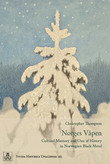Sökning: onr:7ht5cwpb53576427 > Norges Våpen
- 1 av 1
- Föregående post
- Nästa post
- Till träfflistan
Norges Våpen [Elektronisk resurs] Cultural Memory and Uses of History in Norwegian Black Metal
- Thompson, Christopher, 1983- (författare)
- Lindberg, Erik (preses)
- Byström, Mikael (preses)
- Martin, Benjamin (opponent)
- Uppsala universitet Humanistisk-samhällsvetenskapliga vetenskapsområdet (utgivare)
- Publicerad: Uppsala : Acta Universitatis Upsaliensis, 2018
- Engelska 221
- Serie: Studia Historica Upsaliensia, 0081-6531 0081-6531
- E-bokAvhandling(Diss. Uppsala : Uppsala universitet, 2018)
Sammanfattning
Ämnesord
Inställningar
Hjälp
Stäng
- This dissertation examines uses of history and expressions of cultural memory in Norwegian black metal. Formed in the late 1980s and early 1990s, Norwegian black metal seemed at odds with many of the stereotypes of Norway. The genre is an extreme style of heavy metal music that has been associated with burning churches, desecrating graves, and committing murders. Yet, Norway is often perceived as wealthy with sublime natural beauty and high levels of equality. Since the late 1990s, Norwegian black metal has increasingly received positive recognition and support from Norwegian government agencies and cultural institutions who have deemed this style of music a cultural product of Norway. In exploring the relationship between Norwegian black metal and Norway, two primary questions are asked: what makes Norwegian black metal ‘Norwegian’ and what are its influences? To answer these questions, a theoretical approach based on Astrid Erll’s cultural memory complex is used. Included in this cultural memory complex are notions of individual and collective memory, both of which include concepts of nationalism as outlined by Benedict Anderson and Michael Billig. The source base for this dissertation includes the musical releases of over five hundred Norwegian black metal bands which were gathered and analyzed. Three primary categories, with corresponding subcategories, were identified to account for the ways Norwegian black metal bands have used history and expressed cultural memory over a twenty-five-year period from 1988 to 2013. This dissertation shows that Norwegian black metal has made frequent use of history and has actively negotiated parts of the identity-making process from nineteenth-century Norway. In connecting to Norwegian identity in such a way, these bands link to historically construed notions of likhet and egalitarian individualism as identified by the Norwegian anthropologists Marianne Gullestad and Thomas Hylland Eriksen. They actively reproduce many of the same essentialized notions of Norwegian identity that create and maintain ethnic boundaries on Norwegian identity. By using history and expressing cultural memory in the way that they do, Norwegian black metal bands communicate that they are firmly Norwegian while, at the same time, reinforcing ethnocentric notions of Norwegian identity.
Ämnesord
- Humanities and the Arts (hsv)
- History and Archaeology (hsv)
- History (hsv)
- Humaniora och konst (hsv)
- Historia och arkeologi (hsv)
- Historia (hsv)
- Historia (uu)
- History (uu)
Genre
- government publication (marcgt)
Indexterm och SAB-rubrik
- Norwegian black metal
- cultural memory
- nationalism
- national romanticism
- uses of history
- popular music
- egalitarian individualism
- likhet
- Norway
Uppgift om bibliotek saknas i LIBRIS
Kontakta ditt bibliotek, eller sök utanför LIBRIS. Se högermenyn.
- 1 av 1
- Föregående post
- Nästa post
- Till träfflistan
Sök vidare
Hjälp
- Fler titlar av
- Thompson, Christophe ...
- Lindberg, Erik
- Byström, Mikael
- Martin, Benjamin
- Uppsala universitet ...
- Fler titlar om
- Humanities and the A ...
- History and Archaeol ...
- History
- Humaniora och konst
- Historia och arkeolo ...
- Historia
- visa fler...
- visa färre...
- Fler titlar i denna genre
- government publicati ...
- Serie
- Fler delar
Sök utanför LIBRIS
Hjälp
- Sök vidare i:
- Google Book Search
- Google Scholar
- LibraryThing
Kungliga biblioteket hanterar dina personuppgifter i enlighet med EU:s dataskyddsförordning (2018), GDPR. Läs mer om hur det funkar här.
Så här hanterar KB dina uppgifter vid användning av denna tjänst.
Copyright © LIBRIS - Nationella bibliotekssystem

